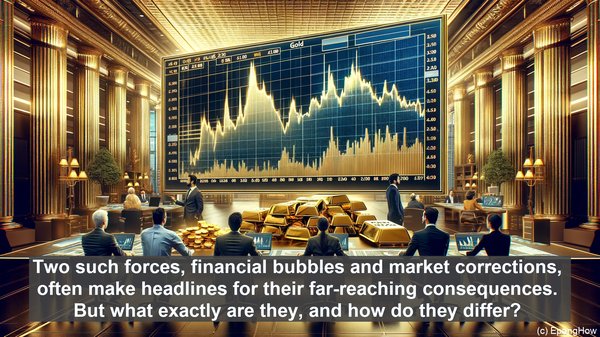Introduction: The Ebb and Flow of Financial Markets
Greetings, fellow enthusiasts of finance! As we navigate the ever-changing landscape of the global economy, it becomes crucial to comprehend the forces that shape it. Two such forces, financial bubbles and market corrections, often make headlines for their far-reaching consequences. But what exactly are they, and how do they differ? Let’s embark on this enlightening exploration together.

Financial Bubbles: The Tempting Mirage
Imagine a scenario where the value of a particular asset, be it stocks, real estate, or even cryptocurrencies, skyrockets at an unprecedented pace. This meteoric rise, often fueled by a collective optimism and herd mentality, creates what we call a financial bubble. At its core, a bubble is an overvaluation of an asset, detached from its intrinsic worth. It’s a captivating mirage, luring in investors with promises of astronomical returns.
The Anatomy of a Bubble: Warning Signs and Catalysts
Bubbles, however, aren’t formed overnight. They are often a result of multiple factors aligning. One such factor is the ‘herd mentality,’ where investors, driven by the fear of missing out, pour their funds into the asset, further inflating its value. Media hype and speculative trading also play a significant role. But like any mirage, the bubble is bound to burst, leading to a sudden and drastic decline in the asset’s value.

Market Corrections: The Balancing Act
Contrasting the exuberance of a bubble, a market correction is a more natural and necessary occurrence. It’s a self-correcting mechanism that brings the asset’s value back in line with its fundamentals. While a correction might seem alarming, it’s an integral part of a healthy market. It prevents the formation of unsustainable bubbles and ensures a more stable and sustainable growth trajectory.
The Triggers of a Correction: Understanding the Catalysts
Unlike bubbles, corrections aren’t driven solely by speculative behavior. They can be triggered by various factors, such as economic indicators, geopolitical events, or even policy changes. For instance, a sudden increase in interest rates might lead to a correction in the real estate market. Similarly, a shift in global trade dynamics can impact the stock market. These corrections, though often unsettling, are essential for the market’s long-term equilibrium.
Navigating the Waters: Strategies for Investors
For investors, both bubbles and corrections present unique challenges and opportunities. While the allure of a bubble’s growth might be tempting, it’s essential to exercise caution and not get swayed by the hype. Diversification, thorough research, and a long-term perspective are crucial. During a correction, on the other hand, it might be an opportune time to identify undervalued assets and make strategic investments.
